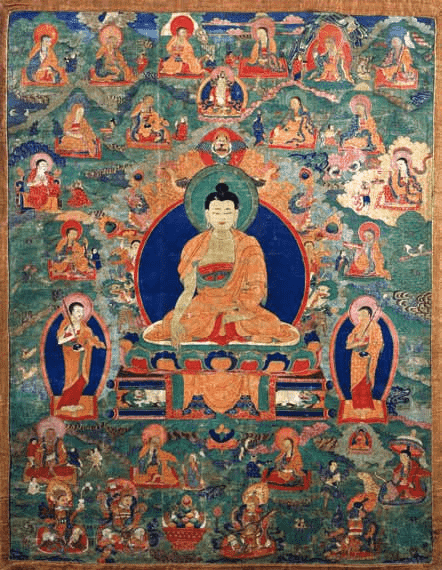Saga Dawa (Sanskrit Vaiśākha) is the fourth month of the Tibetan lunar calendar and is considered the most important Buddhist holiday period of the year. The month’s name derives from the clan of Śākya, and the Buddha’s epithet, Śākyamuni, translates as “the sage of the Śākyas”. In Tibetan, it is also known as Bumgyur Dawa, “the 100,000 multiplying month”, as all skillful and unskillful actions are said to be multiplied by 100,000 times.
The month, and particularly the first fifteen days are auspicious for dharma practice and cultivating any positive actions with body, speech and mind. It is also important to make special efforts in avoiding unwholesome activities. The full moon day, known as Saga Dawa Düchen (the 15th day on the lunar calendar), commemorates the major events of Buddha Śākyamuni’s birth, awakening, and parinirvāṇa.
Because this month witnessed these great events, Buddhists throughout the world believe that the results of our actions are multiplied during this time. Thus, any positive or negative karma we create with body, speech, or mind is multiplied. You can learn more about multiplying merit here.
As with other Buddhist holidays, we celebrate these auspicious events by recalling the kindness of the Buddha. Traditionally, people gathered to recite tales of the Buddha’s life story. And in ancient India, local leaders sponsored processions in which devotees carried statues of the Buddha throughout the towns.
Even if we can’t sponsor a procession, it would be wonderful if we can all take some time to read portions of the life story of the Buddha, such as the wonderfully poetic Lalitavistara, “The Play in Full.” Additionally, we can reflect on the qualities of the Buddha, such as those listed in Chapter 3 of the Samādhirājasūtra, “The King of Samādhis sūtra.”
Qualities of the Buddha from the Samādhirājasūtra
The Tathāgata is the natural result of merit. He is the inevitable result of roots of merit. He is adorned by patience. He is the manifestation of a treasure of merit. He is beautified by the excellent primary signs of a great being. He has the blossomed flowers of the secondary signs of a great being. He is exemplary in his conduct. His appearance is never disagreeable. He brings joy to those motivated by faith. He is invincible in his wisdom. He has the invulnerability of the strengths. He is the teacher of all beings. He is the father of all bodhisattvas. He is the king of all noble individuals. He is the caravan leader for those beginning on their journey. He is immeasurable in his wisdom. He is inconceivable in his eloquence.
He is pure in his voice. He is delightful in his speech. He is lovely in his physical form. He is unequaled in body. He is unstained by the desire realm. He is unsullied by the form realm. He is unadulterated by the formless realm. He is free from suffering. He is liberated from the skandhas. He is separated from the dhātus. He has restrained the āyatanas. He has cut through the knots. He is free from torment. He is released from craving. He has crossed over the great river. He is complete in his wisdom. He is established in the wisdom of the buddha bhagavāns of the past, future, and present. He does not remain in nirvāṇa. He resides at the summit of existence. He is on the level of seeing all beings. Young man, those are the buddha qualities of a tathāgata.
Inspired by these qualities, we can take time to reset our motivation and to make efforts in practice for the benefit of all sentient beings.
Traditionally, Tibetan Buddhists engage in virtuous practices during this period. These may include giving to the needy, practicing of prostrations and making light offerings. Additionally, many practice saving animal lives or undertake pilgrimage to sacred places. Moreover, any positive actions such as observing respectful conduct, being more present for others or becoming more generous and kind, are all worthy commitments to make and strengthen at this time.
As we recall the qualities of the Buddha, one excellent and concise method is to practice Mipham Rinpoche’s Treasury of Blessings Śākyamuni text.
Generosity and Other Meritorious Practice during Saga Dawa
Traditionally, we devote additional time and energy to the practices of generosity and the performance of meritorious deeds. For example, we might practice life release. Thus, we can purchase animals that otherwise like earthworms, shellfish or fish that otherwise would die violently. Then we release them into the environmentally appropriate natural habitats while making prayers and positive aspirations. When we give the gift of life we also extend the donor’s lifespan and create positive circumstances. Other practitioners also may wish to practice life generosity by eating a purely vegetarian diet during the month, or at least on the full moon day.
If we are able, this is a wonderful month to go on pilgrimage and visit sacred sites. Even those of us who are far from the sacred sites, temples, and stupas of Asia may make a special visit to a Buddhist center near us. There, we can take some extra time to circumambulate the shrine buildings and to make offerings of lights, water, or flowers. As we circumambulate, we may wish to recite the mantra of Śākyamuni Buddha.
oṃ mune mune mahāmunaye svāhā
We refer to this mantra also as the “Heart Mantra of the Great Sage” (Skt. munīndrahṛdayamantraḥ).



